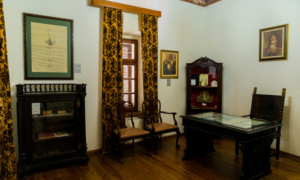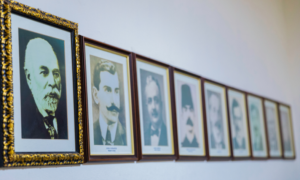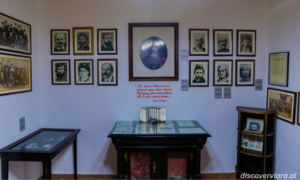Description
Muzeu Kombetar i Pavaresise, ndodhet ne zonen e Skeles se Vlores, ne nje ndertese dykateshe buze detit. Eshte nje nga ndertesat me të rendesishme dhe simbolike, per historine e pavaresise kombetare dhe shtetformimit. Ndertesa ne te dy katet ka rreth shtate pavjone dhe dy holle, ndersa pamjen e saj te thjeshte katerkëndore e thyen nje ballkon me pamje nga deti, i cili mbeshtetet ne dy kollona me seksion rrethor qe i japin nje pamje dinjitoze. Kjo ndertese e cila fillimisht ka sherbyer si ndertese e Karantines, pas shpalljes se pavaresise kombetare me 28 Nentor te vitit 1912, u be selia e Qeverise se Perkohshme te Ismail Qemalit per 14 muaj, deri ne 22 Janar te vitit 1914, kur Ismail Qemali u largua nga kjo ndertese pèr te marre anijen drejt Italise. Ne ballkonin e saj eshte shkrepur edhe fotografia e famshme me rastin e një vjetorit te Shpalljes se Pavarèsise, me 28 Nentor 1913. Me 8 Tetor te vitit 1936 godina historike u kthye ne te parin Muze Arkeologjk ne Shqiperi, ku u vendos koleksioni i pasur me objekte të nxjerra nga germimet dymbedhjetvjeçare ne Apolloni te misionit arkeologik Francez i drejtuar nga arkeologu Leon Rey. Per fat te keq me pushtimin e Shqiperise nga Italia ne Luftën e Dyte Boterore, disa nga objektet e koleksionit u demtuan dhe grabiten. Ne kuadrin e 50 vjetorit te Pavaresise Kombetare me 27 Nëntor 1962, ne kete ndertese u be perurimi i Muzeut te Pavaresise Kombetare, ne prani te autoriteteve me te larta te vendit dhe perfaqesuesve te disa kolonive shaiptare ne Sofje, Australi, France, Amerike etj. Per disa dekada, deri sa u ngrit Muzeu Historik Kombetar ne Tiane, Muzeu i Pavaresise perfaqesonte nje nder realizimet me te spikatura te muzeologise Shqiptare, një muze me permasa e hapesire te gjere, qe pasayronte nje periudhe qe shkonte qysh nga hapat e para te Rilindjes sone Kombetare, shpalljen e Pavaresise Kombetare dhe veprimtaria e qeverise provizore te kryesuar nga Ismail Qemali.
The National Museum of Independence is located in the Skele area of Vlora, in a two-story building by the sea. It is one of the most important and symbolic buildings for the history of national independence and state formation. The building on two floors has about seven pavilions and two halls, while its simple quadrangular appearance is broken by a balcony overlooking the sea, which is supported by two columns with a circular section that give it a dignified appearance. This building, which initially served as a Quarantine building, after the declaration of national independence on November 28, 1912, became the headquarters of Ismail Qemali's Provisional Government for 14 months, until January 22, 1914, when Ismail Qemali was left this building to take the ship to Italy. On its balcony, the famous photo was taken on the occasion of the one year anniversary of the Declaration of Independence, on November 28, 1913. On October 8, 1936, the historic building turned into the first Archaeological Museum in Albania, where the rich collection of objects extracted from the twelve-year excavations in Apollo of the French archaeological mission directed by the archaeologist Leon Rey. Unfortunately, with the occupation of Albania by Italy in the Second World War, some of the objects in the collection were damaged and looted. In the context of the 50th anniversary of National Independence on November 27, 1962, the Museum of National Independence was inaugurated in this building, in the presence of the highest authorities of the country and representatives of several Shaiptar colonies in Sofia, Australia, France, America, etc. For several decades, until the National Historical Museum was established in Tiana, the Museum of Independence represented one of the most outstanding achievements of Albanian museology, a museum with a large size and space, which commemorated a period that went back to the first steps of the Renaissance our Nation, the declaration of National Independence and the activity of the provisional government headed by Ismail Qemali.







Add a review